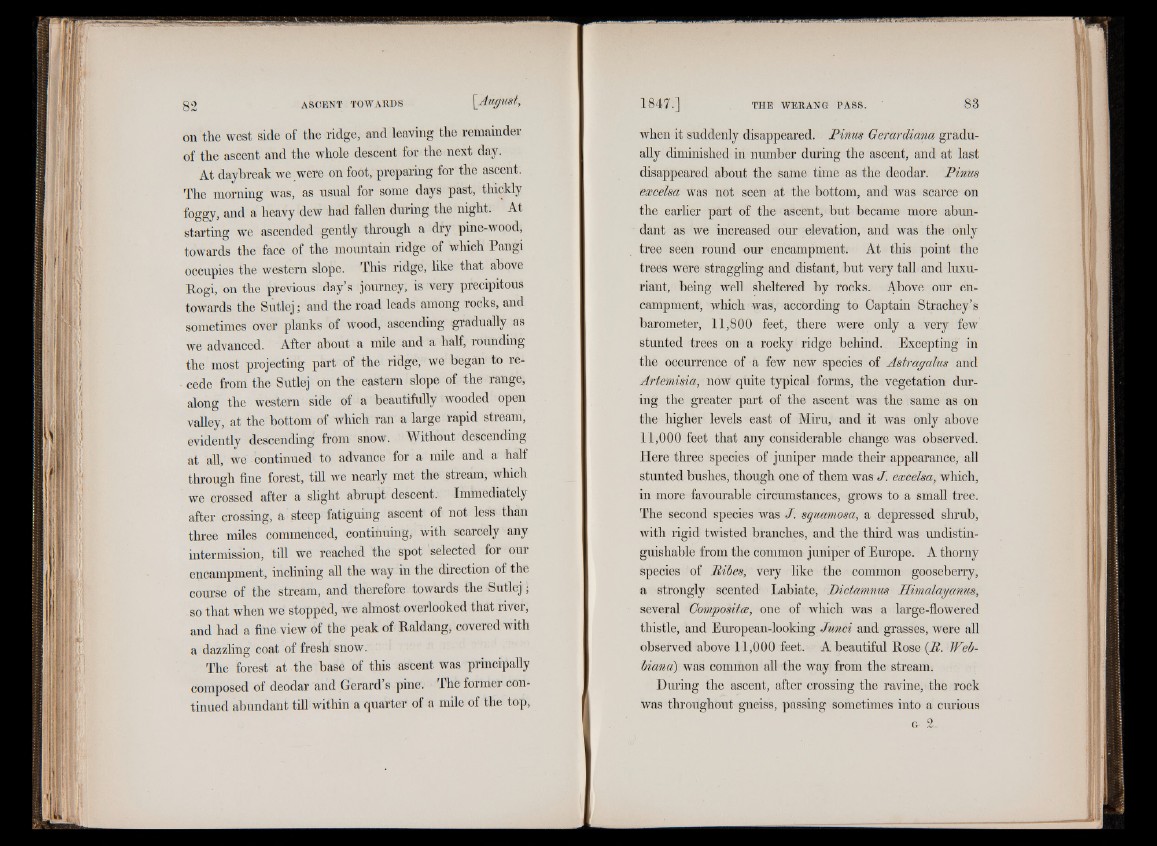
on the west side of the ridge, and leaving the remainder
of the ascent and the whole descent for the next day.
At daybreak we were on foot, preparing for the ascent.
The morning was, as usual for some days past, thickly
foggy, and a heavy dew had fallen during the night. At
starting we ascended gently through a dry pine-wood,
towards the face of the mountain ridge of which Pangi
occupies the western slope. This ridge, like that above
Rogi, on the previous day’s journey, is very precipitous
towards the Sutlej; and the road leads among rocks, and
sometimes over planks of wood, ascending gradually as
we advanced. After about a mile and a half, rounding
the most projecting part of the ridge, we began to recede
from the Sutlej on the eastern slope of the range,
along the western side of a beautifully wooded open
valley, at the bottom of which ran a large rapid stream,
evidently descending from snow. Without descending
at all, we continued to advance for a mile and a half
through fine forest, till we nearly met the stream, which
we crossed after a slight abrupt descent. Immediately
after crossing, a steep fatiguing ascent of not less than
three miles commenced, continuing, with scarcely any
intermission, till we reached the spot selected for our
encampment, inclining all the way in the direction of the
course of the stream, and therefore towards the Sutlej;
so that when we stopped, we almost overlooked that river,
and had a fine view of the peak of Raldang, covered with
a dazzling coat of fresh snow.
The forest at the base of this ascent was principally
composed of deodar and Gerard’s pine. The former continued
abundant till within a quarter of a mile of the top,
when it suddenly disappeared. Pinus Gerardiana gradually
diminished in number during the ascent, and at last
disappeared about the same time as the deodar. Pinus
excelsa was not seen at the bottom, and was scarce on
the earlier part of the ascent, but became more abundant
as we increased our elevation, and was the only
tree seen round our encampment. At this point the
trees were straggling and distant, but very tall and luxuriant,
being well sheltered by rocks. Above our encampment,
which was, according to Captain Strachey’s
barometer, 11,800 feet, there were only a very few
stunted trees on a rocky ridge behind. Excepting in
the occurrence of a few new species of Astragalus and
Artemisia, now quite typical forms, the vegetation during
the greater part of the ascent was the same as on
the higher levels east of Miru, and it was only above
11,000 feet that any considerable change was observed.
Here three species of juniper made their appearance, all
stunted bushes, though one of them was J. excelsa, which,
in more favourable circumstances, grows to a small tree.
The second species was J. squamosa, a depressed shrub,
with rigid twisted branches, and the third was undistin-
guishable from the common juniper of Europe. A thorny
species of Ribes, very like the common gooseberry,
a strongly scented Labiate, Dictamnus Himalayanus,
several Composites, one of which was a large-flowered
thistle, and European-looking Junci and grasses, were all
observed above 11,000 feet. A beautiful Rose {R. Web-
biana) was common all the way from the stream.
During the ascent, after crossing the ravine, the rock
was throughout gneiss, passing sometimes into a curious